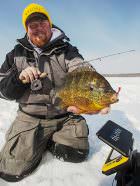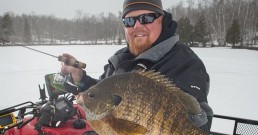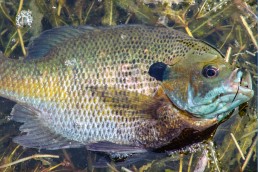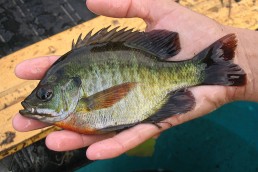Big Bluegills Swim Circles around Winter Blues
SHARE THIS POST
Have I ever mentioned that I love bluegills?
My version of curing the “midwinter blues” involves ‘gills, fins and chubby bellies swimming around in circles below my ice fishing hole.
January is admittedly the low point of the winter, but by the end of January, the fish are starting to feel the days getting longer and winter starting to lose its grip on the landscape.
Bluegills don’t have the luxury of going into semi-hibernation like some of the larger fish during the dead of winter. Muskies, pike, bass and big walleyes have substantial fat reserves and can eat much larger meals at one time, so they don’t have to feed nearly as often during the cold water period as smaller fish like bluegills.
Bluegills feed mostly on microscopic prey like zooplankton or insect larvae. Their prey is usually smaller than the size of a shelled sunflower seed and they have to hunt them down and catch them one at a time. Bluegills have no choice other than keep grazing in order to survive.
Bluegill location in midwinter can vary greatly between lakes. Their location is largely based on what is available in their home lake and the population dynamics between the bluegills and their competitors, as well as between them and the predators living in the lake.
Many factors help determine where the best feeding opportunities for bluegills are located in each lake. Anglers need to study their lake maps and figure out where the bluegills are most likely to be, based on what they know about the lake.

Many lakes have the best feeding areas in the basin, while other lakes may have better opportunities for bluegills on the weed flats.
Bluegills living in the basin may be in little depressions or rises on the flats, they may be in the deepest trench or they may be on the edges of the basin in isolated areas between other structures.
Bluegills living on the weed flats usually prefer different types of micro-edges, like the edges of stubble weeds, pockets between weeds, patches of rocks or any other physically different types of areas that distinguish one part of the flat over the rest of the flat.
Many lakes have multiple areas that appeal to bluegills, so bluegills can be more selective in the types of locations they prefer.
Bluegills sometimes act like smallmouth bass and use complex areas that give them everything they need in all seasons of the year. They are able to move around the larger structure at different times of the year, without having to leave the general area.
Lakes where the basin provides the best feeding opportunity for bluegills will tend to have most of the bluegills feeding on edges of the basin, closer to the breakline. Bluegills usually prefer mud flats in the upper teens to the 20s in depth, while perch and crappies often prefer deeper basin areas in the 30s and deeper.
Lakes with high densities of bluegills often have bluegills and crappies mixed in the same locations, with both species competing for the same food sources.
Bluegills have binocular vision, so they can see microscopic sized prey in the water. This also means they can see anglers’ presentations, so keep that in mind when selecting lure size and line weight.
Are you enjoying this post?
You can be among the first to get the latest info on where to go, what to use and how to use it!
Population dynamics are huge with bluegills. They are some of the most complicated fish in the lakes as far as spawning habits and what happens to bluegill populations when the larger fish become overharvested.
Bluegills grow up to five times faster when they are in the juvenile phase than they do when they are adults. This means they need to stay in the juvenile phase as long as possible in order to reach their maximum growth potential.
Bluegills are fiercely competitive for spawning sites and about as particular as whitetail deer when it comes to selecting their mates. The little bucks don’t get the does any more than the little bull bluegills get the biggest hens.
Young male bluegills have to grow large enough in the juvenile phase to be able to compete for nesting sites with the largest bluegills before they mature and their growth rate is stunted. If the bluegill population has been overharvested, then the juvenile bluegills don’t have to grow as large before they mature in order to compete.
The mature adult bluegills in a stunted population still continue to grow, but at a much slower rate. Anglers need to release the larger bluegills for the genetics of the lake, which usually means all bluegills longer than 9 inches.
Anglers harvesting bluegills should take them from one of the strongest age classes in the lake, which usually means keeping fish that are eight inches or less.
Depth is a key factor when releasing bluegills. It is difficult for bluegills caught in water deeper than the low 20s to get back to the bottom without suffering barotrauma, which is basically the same thing as “the bends.”
The mortality rate of released bluegills caught out of deep water is much lower than most anglers realize. Many of them end up floating in the hole or just under the ice around the edges of anglers’ holes.
Anglers should fish shallow enough to be able to release the big bluegills or fish “guilt-free” lakes with stunted populations and keep everything you catch if fishing out of deep water.
Presentation is the last factor to consider. I like to use a 6-inch bit on my Nils Master ice auger and leave some slush in the hole to block the spotlight effect of the sun.
I like to use 2- or 3-pound-test Northland Bionic Ice fluorocarbon for most of my bluegill rods. The line is tough and it gives the small lures better action than heavier line.
My favorite rod for bluegills is the Frabill “Bro-Series” Quick-Tip ultra-light with the 371 straight-line reel. The straight-line reel is important to minimize line twist and to keep the lure from spinning when I am trying to hold it still.
Tungsten jigs are all the rage with many anglers, but I often prefer a slower drop like I get with the Northland Helium Fly. I will use an impulse plastic on the Helium Fly or tip it with a single wax worm or a couple maggots, depending on what I am observing on my Humminbird sonar.
Have I mentioned I love bluegills? I love them enough to let the big ones go––and so should you!
MWO
SHARE THIS POST
Did you enjoy this post?
You can be among the first to get the latest info on where to go, what to use and how to use it!
Brian 'Bro' Brosdahl
Outdoor communicator Brian “Bro” Brosdahl lives in northern Minnesota. He is a walleye guide in the Cass Lake, Leech Lake and Lake Winnibigoshish areas. He is sponsored by Northland Fishing Tackle, Frabill/Plano, Aqua-Vu, Humminbird/Minn Kota, St. Croix Rods, Ranger Boats, and Evinrude. Guide inquiries: brosguideservice.com. Follow on social media.



